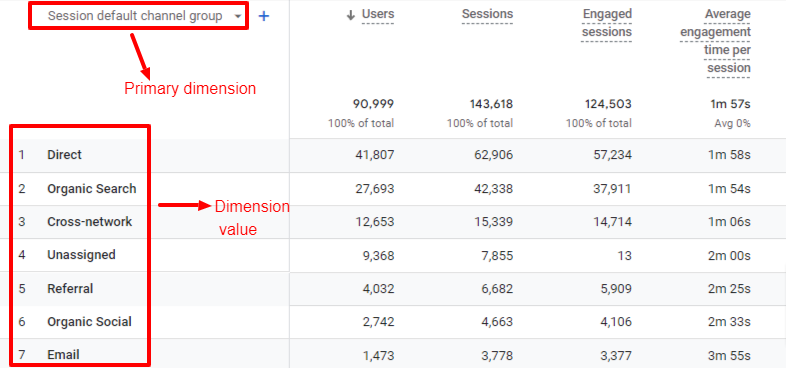Comprehensive Insights Using Secondary Dimension in Google Analytics
Comprehensive Insights Using Secondary Dimension in Google Analytics
Blog Article
Transform Your Analytics Method With Second Dimension in Google Analytics
By integrating second measurements right into data evaluation, a new layer of insights emerges, shedding light on elaborate user behaviors and communications. The critical application of secondary dimensions holds the key to unlocking a prize chest of invaluable information that can reinvent exactly how companies translate and act upon their data.
Comprehending Additional Dimensions in Google Analytics
Second dimensions in Google Analytics give additional context to key data by permitting individuals to evaluate metrics throughout a 2nd measurement, supplying deeper understandings right into user behavior and interactions on a web site. Secondary Dimension in Google Analytics. While main dimensions offer basic information factors such as pageviews, bounce rate, and session duration, additional dimensions use an even more comprehensive sight by segmenting the main information further. This division enables individuals to analyze metrics in mix with another dimension, such as web traffic resources, demographics, or user actions
Advantages of Utilizing Second Measurements
Making use of second measurements in Google Analytics uses a critical advantage by improving the deepness of evaluation and giving a much more extensive understanding of individual communications and habits on an internet site. By incorporating second dimensions, experts can obtain valuable understandings right into the efficiency of particular segments or variables within their information. This makes it possible for a more detailed evaluation of individual habits beyond surface-level metrics, enabling a deeper exploration of the elements affecting customer engagement and conversions.

How to Carry Out Second Dimensions
When including secondary measurements in Google Analytics, one necessary step is to select the pertinent metrics and measurements to enhance the analysis process. Clicking on this switch will open a drop-down menu listing numerous measurements that can be included to your key dimension for deeper understandings.
After choosing the appropriate secondary dimension, such as 'Source/Medium' or 'Tool Classification,' Google Analytics will certainly show the data in a more comprehensive style, permitting you to cross-analyze various facets of individual habits. Bear in mind to try out different mixes of second and primary dimensions to discover valuable patterns and trends that can notify your marketing techniques. By executing secondary dimensions attentively, you can gain an extra detailed understanding of your site or application efficiency and make data-driven choices to maximize your digital presence.
Analyzing Information With Secondary Measurements
Improve your information analysis in i loved this Google Analytics by integrating second measurements to dig deeper into user actions patterns and optimize your electronic advertising techniques properly - Secondary Dimension in Google Analytics. By including second dimensions to your primary data, you can acquire beneficial understandings that can help you make educated choices concerning your website or app performance
Analyzing data with secondary dimensions enables you to segment your main data even more, offering an extra extensive sight of individual communications. For circumstances, combining the primary dimension of 'source/medium' with an additional measurement like 'landing web page' can expose which specific pages are driving traffic from different sources. This info can be crucial in refining your content approach or maximizing your advertising campaigns to boost conversions.
Moreover, using additional dimensions enables you to recognize correlations in between various metrics, helping you understand the influence of various factors on individual behavior. Whether it's analyzing demographics alongside individual engagement metrics or device classifications with conversion prices, additional dimensions empower you to discover hidden trends and patterns that can lead your marketing efforts.
Enhancing Performance With Additional Measurements
To enhance the performance of data analysis and decision-making in Google Analytics, integrating secondary dimensions is essential to maximizing efficiency metrics and getting deeper understandings into user habits patterns. By using secondary measurements, experts can dive beyond surface-level information and reveal important relationships that may or else go unnoticed. This optimization method enables companies to tailor their advertising initiatives a lot more effectively, recognize locations for improvement in internet site usability, and improve general individual experience.
Second measurements provide an even more detailed sight of customer interactions by offering additional context to primary information metrics. For instance, matching the primary measurement of 'landing web page' with a secondary dimension like 'device category' can reveal whether particular devices are more probable to drive engagement go to this website on specific touchdown web pages. This understanding can inform responsive style renovations or targeted marketing approaches to increase performance.

Verdict
Finally, the combination of second measurements in Google Analytics supplies organizations with an effective device to boost their analytics technique. Secondary Dimension in Google Analytics. By delving deeper into user behavior and interactions, marketers can uncover beneficial understandings that can drive performance optimization and improve the general user experience. Leveraging secondary dimensions permits for a much more extensive evaluation of data, causing more educated decision-making and customized advertising and marketing efforts
Second measurements in Google Analytics provide added context to see main information by permitting customers to assess metrics throughout a second dimension, offering much deeper insights into customer actions and communications on a website. While main measurements give essential data factors such as pageviews, bounce rate, and session period, secondary dimensions supply an even more detailed sight by segmenting the main data additionally.One of the key advantages of utilizing secondary measurements is the ability to uncover relationships and patterns that might not be promptly obvious when assessing data with key measurements alone.When incorporating secondary dimensions in Google Analytics, one necessary action is to pick the pertinent metrics and dimensions to enhance the analysis process. Pairing the key measurement of 'landing web page' with a second measurement like 'tool category' can expose whether particular devices are more most likely to drive engagement on particular landing web pages.
Report this page